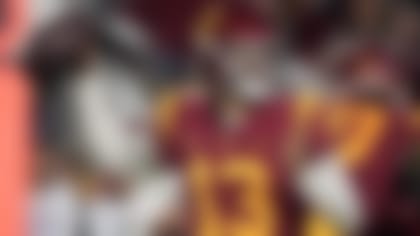The NBA Finals matched two first-year coaches, and Steve Kerr's Golden State team outdueled David Blatt's Cleveland squad. In the process, Kerr became the first first-year coach to win the NBA title since Pat Riley with the Los Angeles Lakers in 1982.
Only one college football coach has won the national title in his first season. His achievement, naturally, is atop our list of the "dandy dozen" performances turned in by first-year coaches in the sport. Here's a look at the top jobs done by first-year coaches since 1960.
12. Bill Battle, Tennessee
Year 1970
Skinny: The Vols finished 10-1 and ranked fourth in the nation (they were unranked in the preseason), winning the Sugar Bowl over Air Force (that is the most recent appearance by a service academy in a "big" bowl). Tennessee had won the SEC in 1969, but coach Doug Dickey left for Florida, his alma mater. Battle had been offensive coordinator and he was promoted; he was 28 and the youngest head coach in college football at the time. In Battle's first season, the Vols held eight foes to fewer than 10 points and only one scored more than 18; that was Auburn, which beat Tennessee 36-23 in the second game of the season. The Vols then won out and took their second consecutive SEC title. Battle currently is the AD at Alabama, his alma mater.
11. Ara Parseghian, Notre Dame
Year 1964
Skinny: The Irish finished 9-1 and ranked third (the preseason poll included just a top 10, and the Irish were not in it); at that time, Notre Dame didn't partake in bowl games. Notre Dame had gone 2-7 in 1963, which led to the firing -- after only one season -- of Hugh Devore. Parseghian was hired away from Northwestern and proceeded to lead the Irish to a 9-0 record and a No. 1 ranking; the only loss came in the season finale, 20-17 at USC. That was the only contest in which the Irish allowed more than 15 points; they held foes to seven or fewer points seven times that season.
10. Chuck Fairbanks, Oklahoma
Year 1967
Skinny: The Sooners finished 10-1 and ranked third (the preseason poll included just a top 10, and OU was not in it), upsetting No. 2 Tennessee in the Orange Bowl. Fairbanks was promoted from offensive coordinator after the death of Jim McKenzie, 37, in April 1967. OU went 6-4 in '66 in McKenzie's lone season as coach. The Sooners outscored opponents 290-92 in '67; the only loss was a 9-7 setback to Texas. The Sooners, who won the Big Eight title for the first time in five years, held 10 of their 11 foes to 14 or fewer points.
9. Fred Akers, Texas
Year 1977
Skinny: The Longhorns finished 11-1 and ranked fourth (they were unranked in the preseason poll); they were No. 1 going into the bowls but fell to Notre Dame in the Cotton Bowl. Akers was a longtime assistant at Texas before leaving to become coach at Wyoming in 1975 and '76; he returned to Texas to replace the legendary Darrell Royal, who retired after a 5-5-1 mark in '76. Texas opened 3-0 in '77, outscoring its foes 184-15 in those games, and kept cruising -- until the Cotton Bowl. The Irish hammered the Longhorns 38-10. The same thing happened to Texas in 1983 -- unbeaten and No. 1 going into the bowls, only to lose in the Cotton Bowl (it was to Georgia in '83). Akers eventually left Texas to coach Purdue. (Think about that for a second.) Purdue's quarterback when Akers got there in 1987? Jeff George -- who quickly transferred to Illinois because he wanted nothing to do with Akers' run-oriented offense.
8. Earle Bruce, Ohio State
Year 1979
Skinny: The Buckeyes finished 11-1 and ranked fourth (Ohio State was unranked in the preseason poll); they had been No. 1 going into the bowls but lost 17-16 to USC in the Rose Bowl. Bruce was coach at Iowa State when he was hired to replace Woody Hayes, who was fired after he punched a Clemson player during the 1978 Gator Bowl. Bruce took over a talented team but also was following a legend. The team certainly responded to the coaching change: The Buckeyes steamrolled to an 11-0 record and a No. 1 ranking. Seven of the first 10 opponents scored eight or fewer points, including a six-game stretch in which no opponent scored more than seven. But the Trojans ended Bruce's storybook first season when TB Charles White scored the game-winning touchdown in the final minute of the Rose Bowl.
7. Terry Bowden, Auburn
Year 1993
Skinny: The Tigers finished 11-0 and ranked fourth (they were unranked in the preseason poll), but were ineligible for a bowl because of NCAA sanctions committed during the regime of Bowden predecessor Pat Dye. They were the nation's only unbeaten team in '93. Dye was replaced after the '92 season because of the NCAA violations, and Auburn turned to Bowden, who was the coach at Division I-AA Samford in Birmingham, Ala. He also was the son of Florida State coach Bobby Bowden, and the Bowden name carried a lot of weight. Bowden revved up the Tigers' ground-bound offense: Auburn scored at least 30 points eight times in Bowden's first season after doing that just seven times in the previous three seasons combined. Interestingly, Bobby Bowden's one-loss FSU team won the national title, the elder Bowden's first national crown.
6. Urban Meyer, Ohio State
Year 2012
Skinny: The Buckeyes finished 12-0 and ranked third (they were 18th in the preseason poll), but were ineligible for a bowl because of NCAA sanctions committed during the regime of Meyer predecessor Jim Tressel. Meyer had enjoyed a phenomenal run at Florida, winning two national titles in six seasons before stepping down for health reasons after the 2010 campaign. After one season as an ESPN analyst, he returned to the sidelines with the Buckeyes. Ohio State went 6-7 in '11 under interim coach Luke Fickell, but while the defense remained inconsistent in '12, the spread offense installed by Meyer helped Ohio State go unbeaten. The Buckeyes scored at least 50 points four times in '12 and finished off their season by beating Michigan.
5. Chris Petersen, Boise State
Year 2006
Skinny: The Broncos finished 13-0 and ranked fifth (they were unranked in the preseason poll); they upset Oklahoma in overtime in the Fiesta Bowl in one of the most memorable bowl games in history. Petersen was promoted from offensive coordinator after coach Dan Hawkins left for Colorado following a 9-5 record in '05, and Petersen's first season might be the best in school history. The Broncos scored at least 40 points nine times, including an epic 43-42 win over OU in the Fiesta Bowl; that game featured a late-game hook-and-ladder by Boise State that sent the game into overtime, then a two-point conversion on a "Statue of Liberty" play that won the game; the two-point conversion came after Boise State scored on an option pass off an end-around. Boise State finished as the only unbeaten team in the nation and was just the second non-Power Five team to ever appear in a BCS game (Utah in 2004 with Meyer was the first).
4. Barry Switzer, Oklahoma
Year 1973
Skinny: The Sooners finished 10-0-1 and ranked third (they were 12th in the preseason poll), but were ineligible for a bowl because of NCAA sanctions committed during the regime of Switzer predecessor Chuck Fairbanks. Fairbanks bolted for the New England Patriots after the '72 season, and Switzer -- who was the Sooners' offensive coordinator -- was promoted to replace him. OU had gone 11-1 in '72 and Switzer proceeded to go 29-0-1 in his first 30 games as coach. The only blemish in that span was a 7-7 tie at USC in the second game of the '73 season. After that outcome, the Sooners won their remaining nine games in '73 by an average of 27 points per contest. OU scored at least 40 points five times and no opponent scored more than 20. It was the first of eight consecutive Big Eight titles under Switzer.
3. John Robinson, USC
Year 1976
Skinny: The Trojans finished 11-1 and ranked second (they were eighth in the preseason poll). Robinson was a USC assistant under John McKay, then left to become offensive backfield coach of the Oakland Raiders for the 1975 season. When McKay left USC to coach the expansion Tampa Bay Buccaneers, Robinson was hired to replace him. USC had gone 8-4 in McKay's final season, which included a four-game losing streak to end the regular season before the Trojans bounced back to win the Liberty Bowl. USC opened the '76 season with a 21-point home loss to Missouri, then rolled to 11 wins in a row, including a victory over No. 2 Michigan in the Rose Bowl. The Trojans beat then-No. 2 UCLA and then-No. 13 Notre Dame in their final two regular-season games.
2. Gus Malzahn, Auburn
Year 2013
Skinny: The Tigers finished 12-2 and ranked second (they were unranked in the preseason poll); they lost to Florida State in the BCS national championship game. Auburn won the national title in 2010, thanks to the play of QB Cam Newton. Malzahn was the Tigers' offensive coordinator that season, and he left after the '11 season to become coach at Arkansas State. Auburn, meanwhile, fell on its face in 2012, going 3-9, and coach Gene Chizik was fired. Malzahn was hired to replace Chizik, and the Tigers responded by going 11-1 in the regular season. They then hammered Missouri in the SEC championship game before falling 34-31 to Florida State in the final BCS national championship game. The Tigers scored at least 30 points 12 times, including in each of the final 10 games; in addition, Auburn scored at least 43 points six times. Three of the 43-point games and six of the 30-point games came against ranked teams.
1. Larry Coker, Miami
Year 2001
Skinny: The Hurricanes finished 12-0 and won the national title by dismantling Nebraska 37-14 in the Rose Bowl (UM was second in the preseason poll). Coker took over a loaded team after he was promoted from offensive coordinator following Butch Davis' departure to become coach of the Cleveland Browns. How loaded was UM? The starting running backs in the title game were Willis McGahee and Clinton Portis, and Frank Gore was the No. 3 tailback. Andre Johnson was the leading wide receiver. Three members of the starting secondary (Ed Reed, Phillip Buchanon and Mike Rumph) became first-round picks. Jonathan Vilma and D.J. Williams were the top two linebackers. Bryant McKinnie was the star offensive lineman. Jeremy Shockey was the starting tight end. Among the backups: Antrell Rolle, Sean Taylor, Vince Wilfork and Kellen Winslow, Jr. Miami had gone 11-1 under Davis in 2000, with a five-point loss at Washington the only blemish. In '01, the Hurricanes won every game but one by double-digits, won every game but two by at least 22 points and four times won by at least 40 and three times by at least 58.
Here are six other first-year coaches who came close to making our list: LSU's Mike Archer in 1987, Wisconsin's Bret Bielema in 2006, LSU's Charlie McClendon in 1962, Colorado's Rick Neuheisel in 1995, Nebraska's Tom Osborne in 1973 and Texas A&M's Kevin Sumlin in 2012.
Mike Huguenin can be reached at mike.huguenin@nfl.com. You also can follow him on Twitter @MikeHuguenin.













